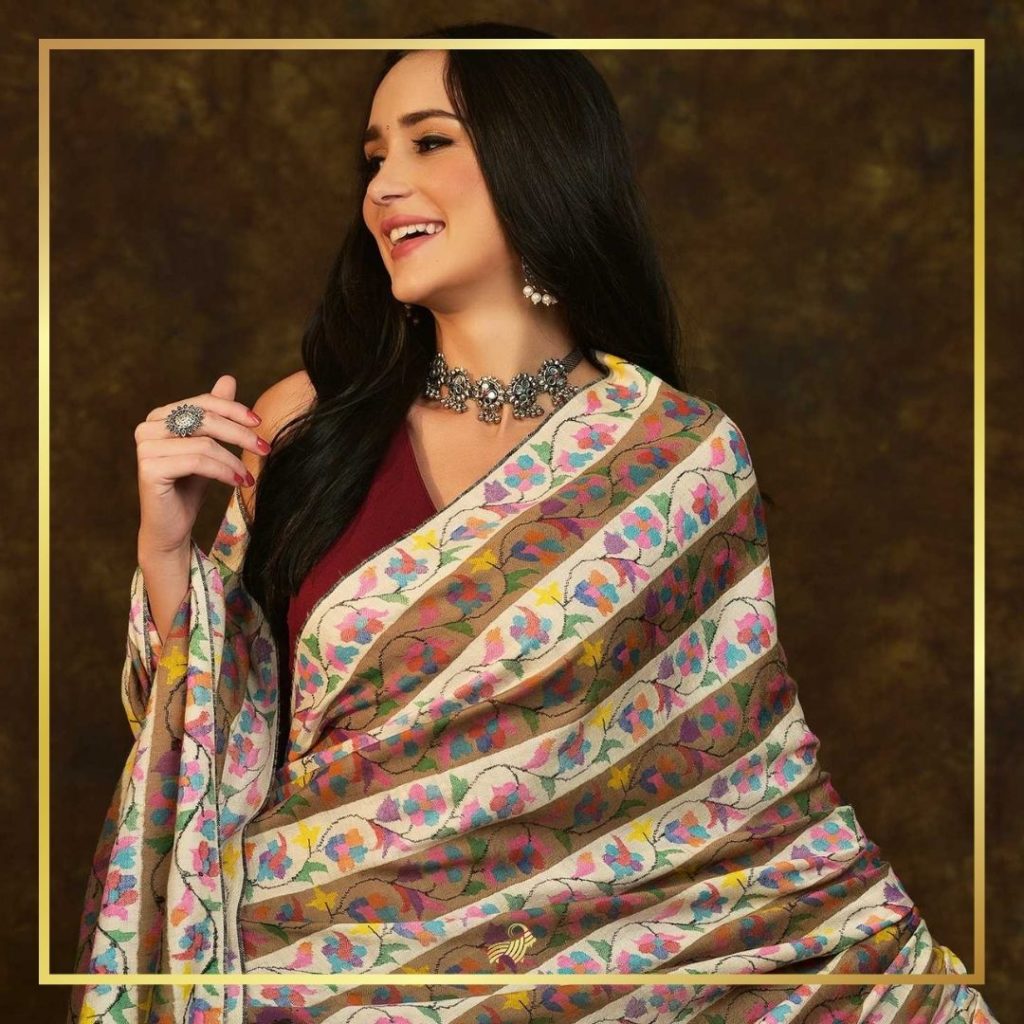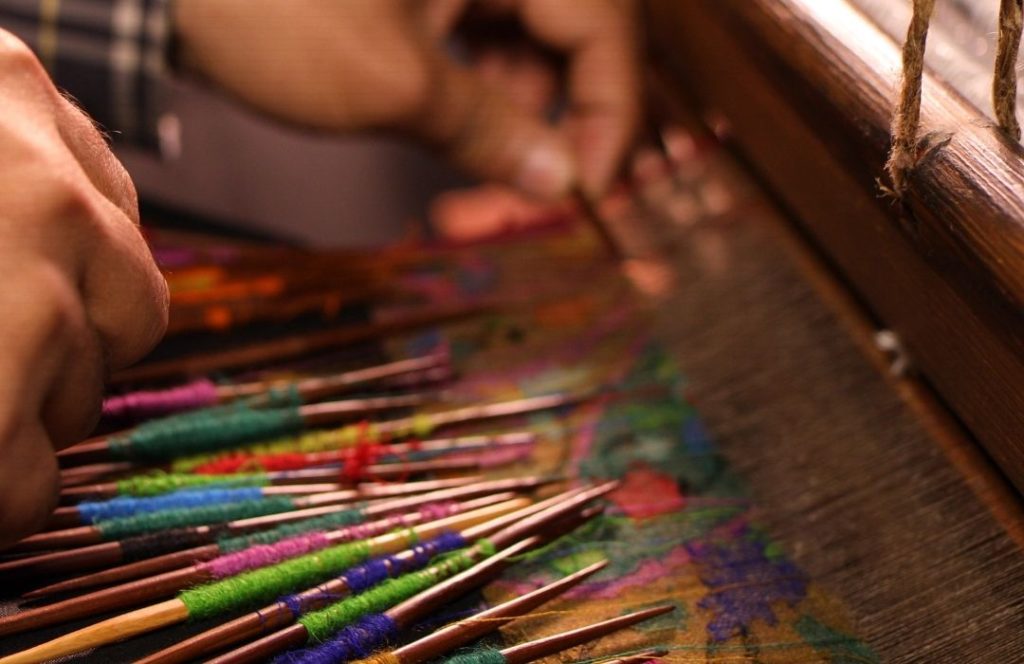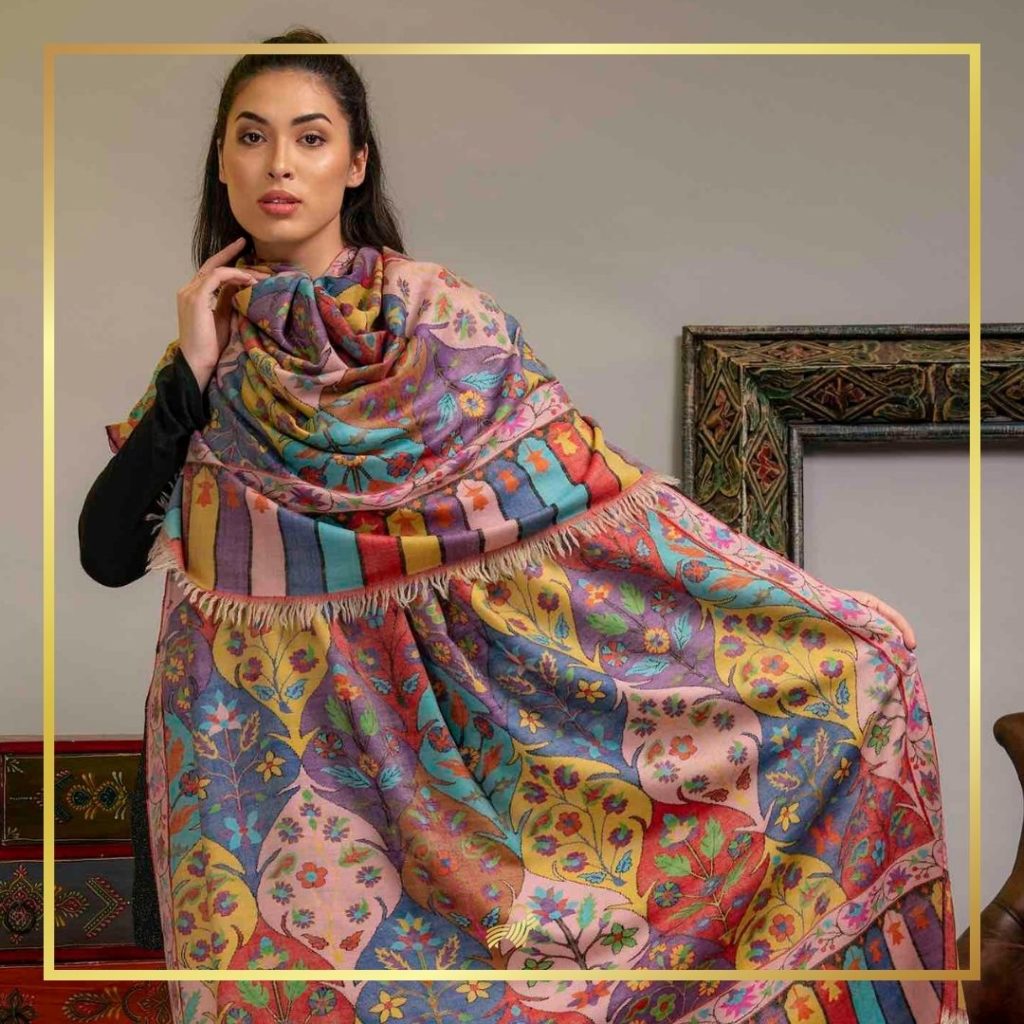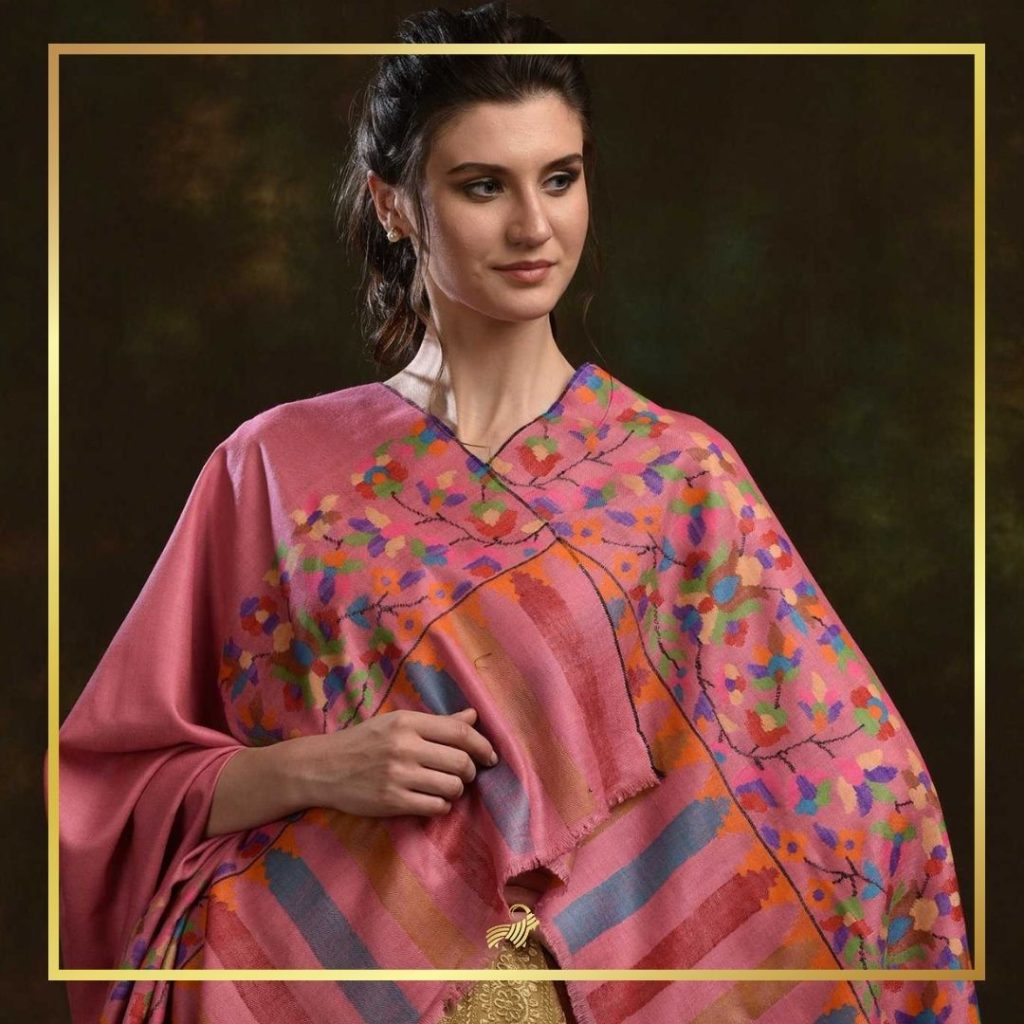A quaint village in the northmost part of India is Kashmir. World-famous for its handicrafts, Kashmir is an eminent place for the production of shawls. Kashmiri shawls are one of the most sought after winter accessories. Hence, women across the globe find Kashmiri shawls of the best quality they have worn, touched, or experienced. Amongst the most luxurious assortments of resplendent shawls, it is Kani Pashmina shawls that stand superior and exceptional. Evidently, Kani shawls are those intricate masterpieces, which need immense attention, careful efforts and soulful endeavours of the maker. Owing to being an epitome of classic art and fine labour, these shawls have been rewarded with the GI. (GI is the Geographical Indication, which specialists use in products that enjoy special features due to their place of origin.
More than just a shawl, a Kani Pashmina is a whisper of the mountains stitched together, with each thread moving to the beat of an age-old craft. With elaborate designs growing like wildflowers across a canvas of the finest Cashmere, it is crafted by the hands of Kashmiri artisans and embodies the essence of the valley. Precisely crafted, the wooden kanis weave tales of paisleys and petals, as though the loom itself hums a timeless tune. Every twist and turn carries the pulse of generations, history coursing through each opulent strand like a river.
The story of Kani Pashmina Shawls
The tales of a Kani Pashmina begin in the snowy mountains of the picturesque Kashmir valley. A village called Kanihama houses all the breathtaking Kani Pashmina shawls. It was in this village that Kani art started. Since the Mughal era, Kanihama and its artisans have produced the most ethereal Kani shawls. And since then, every patron of this lavish art form has owned Kani Pashminas; they believe these to be nothing less than a treasure.
Kani shawls in Pashmina art have been the most loved accessories of the Mughal rulers. Historians believe that King Akbar owned a large number of Kani Pashminas. In fact, he has mentioned of luxury shawls of Kashmir in his autobiography - Ain E Akbari. Moreover, some also believe that the Sufi Persian saint Shah E Hamdan introduced Kani shawl making in Kashmir. It was him who apart from several other crafts introduced this luxury craft as well.
Also read: Kashmiri Shawl left Historical Figures spellbound
History of Kani shawls
Kani shawls, originating in the picturesque Kashmir Valley in India, have a rich history dating back centuries. These shawls are, indeed, famous for their intricate designs, luxurious materials, and meticulous handwork
Early European Encounters:
The European fascination with Kani shawls goes back to the 18th and 19th centuries when European travelers and traders encountered these exquisite textiles during their journeys to the East. The allure of Kani shawls was immediate, and they were quickly recognized as rare and precious treasures.
Napoleon Bonaparte and the Shawl Revolution:
One pivotal moment in the history of Kani shawls in Europe was their association with Napoleon Bonaparte and his court. Napoleon's campaigns in Egypt and India brought him into contact with these luxurious shawls. Also, he was famous for gifting Kani shawls to his wives and influential women in his court. The shawls soon became a fashion statement, and their popularity surged across Europe. Napoleon's affinity for Kani shawls even led to what historians refer to as the "Shawl Revolution" in France.
The Victorian Era and Royal Endorsement:
The Victorian era in the 19th century saw Kani shawls gain further popularity, especially in England. Queen Victoria herself was famous for being a collector of fine textiles. Her endorsement of Kani shawls hence solidified their status as symbols of luxury. European royalty and aristocracy began to embrace Kani shawls as a mark of their refined taste and sophistication.
Influence on European Fashion:
Kani shawls had a profound impact on European fashion during the 19th century. They were integrated into the wardrobes of the elite and often worn as elegant accessories. Kani shawls with their intricate patterns and vibrant colors added a touch of exoticism to European attire. The demand for these shawls led to the creation of European-made imitations, but none could match the authenticity and craftsmanship of the originals from Kashmir.
Kani Shawls in Art and Literature:
The allure of Kani shawls extended to the realms of art and literature. European painters and artists often depicted the shawls in their works, highlighting their beauty and cultural significance. Additionally, writers and poets of the time made reference to Kani shawls in their writings, further cementing their place in European culture.
Modern-Day Appreciation:
Today, Kani shawls continue to receive reverence and admiration in Europe and beyond. In fact, they are highly sought after as collector's items and are valued for their historical significance, intricate craftsmanship, and timeless elegance. Artisans in Kashmir continue to produce these shawls using traditional techniques, ensuring that the legacy of Kani shawls endures
What is Kani?
The word ‘Kani’ refers to small bobbins or small wooden sticks. Kani is made of a forest wood called ‘poos tul.' It is, in fact, these sticks that are responsible for the making of Kani Pashmina shawls. Around these Kanis, artisans wind colourful weft threads to create magical patterns over a shawl. They use as many as 50 Kanis for preparing one single weft when preparing a Kani shawl. This itself speaks about the intricate patterns used and the labour put into it.

An artisan who weaves Kani Pashmina shawls can weave just a square inch a day. Undoubtedly, this shows the complexity of its designs. Artisans use pure Cashmere yarn in the making of Kani Pashminas. Usually, the shawl is a light base. In other words, white, cream or ash base is prefered and the Kani designs woven over it are rich and multicoloured. This creates a striking contrast and the shawl looks like a piece of art.
How is Kani shawl made
Undoubtedly, in the realm of luxury textiles, few can rival the elegance and allure of Kani Pashmina shawls. Artisans weave these exquisite creations from a material that has received reverence for centuries: Kashmiri Cashmere. Hailing from the Ladakhi Changthangi goat, this fine Cashmere wool, which grows on the goat's body, is manually processed to create the luxurious Pashmina shawls that have captivated connoisseurs worldwide.
How is a Kani Pashmina shawl made? This is the most asked and relevant question about Kani Pashminas we encounter.
The Origin of Kashmiri Pashmina:
The story of Kani Pashmina shawls begins with the origin of Kashmiri Pashmina. In detail, it all starts with the Changthangi goat, a unique breed found in the high-altitude regions of Ladakh in India. These goats have adapted to the harsh climate of the Himalayas. In fact, it's their undercoat that holds the secret to the exceptional softness and warmth of Pashmina wool.
The Pashmina Harvest:
The process of obtaining Pashmina is labor-intensive and meticulous. The goats naturally shed their fine undercoat, called Cashmere, during the spring. Following, herders carefully collect this shed wool, locally known as "Pashm,". It is this Pashm or Cashmere that forms the raw material for crafting Pashmina shawls.
Manually Processing Pashmina:
Once collected, the Pashm undergoes a series of manual processes to transform it into the precious Pashmina wool. Herders painstakingly clean, sort the fibre, before artisans carefully spin them . The result is a yarn that is incredibly soft, lightweight, and luxurious.
The Art of Kani Weaving:
With the finest Pashmina yarn in hand, artisans in Kashmir embark on the journey of creating Kani Pashmina shawls. Unquestionably, what sets Kani shawls apart is the intricate weaving technique that bears their name. The term "Kani" refers to the wooden bobbins used in the weaving process. It is, hence, these wooden bobbins which are most essential for creating the intricate patterns and motifs that adorn Kani shawls.
The Meticulous Weaving Process:
The weaving of a Kani Pashmina shawl is a labor of love and precision. Artisans follow detailed pattern charts, inserting hundreds of these wooden bobbins to create the mesmerizing designs. They use around 75 to 100 Kanis at a time to weave a Kashmiri Kani Pashmina. They do this when the shawl is Jamawar - or an overall design shawl. The shawls are woven inch by inch, line by line, and the design is repeated until the final masterpiece is produced. It looks breathtakingly beautiful, feels extraordinarily soft, and feels as warm as the pleasant summer sun.
Each bobbin carries a specific color of yarn, and the weaver carefully selects and inserts the bobbins at precise moments in the weaving process. This meticulous attention to detail ensures that the shawl's designs are ready with unparalleled accuracy.
The Unparalleled Luxury of Kani Pashmina Shawls:
Kani Pashmina shawls get immense admiration for their exceptional softness, warmth, and intricate designs. The blend of the world's finest Pashmina with the artistry of Kani weaving results in a textile that is not merely a garment but a wearable work of art. These shawls are famous for their ability to provide both warmth and elegance, making them highly coveted by those who appreciate the pinnacle of craftsmanship and luxury.
A Timeless Legacy:
The legacy of Kani Pashmina shawls continues to thrive today, with skilled artisans in Kashmir preserving and perpetuating this centuries-old craft. These shawls are more than just fashion accessories; they are tangible pieces of Kashmiri culture, tradition, and heritage. Their timeless appeal and unmatched quality ensure that Kani Pashmina shawls remain a symbol of opulence and artistic mastery, cherished by generations to come

Kani Shawl gets the GI Stamp
To prevent people from creating fake Kani Pashminas outside Kashmir, using other techniques that are not inherent to Kani shawl making, the government rewarded Kani Pashminas with the Geographical Indication (GI) in 2008. This was done to enact the legal protection of the shawl all over the world indicated by the Minister for Industries and Commerce. Kashmiri Pashmina was already GI patented, and then Kani Pashminas made from pure Pashmina too got this prestigious stamp. Hence, if you own a Kani Pashmina from Kashmir, you are the owner of two rare and glorified crafts at once!
Varieties in Kani Pashmina Shawls
There are a number of designs based on the patterns of these shawls, as woven by local artisans.

Kani Jamawar Shawls: Kani Jamawar shawls are the most popular choice when it comes to Kani Pashminas. These shawls have Kani patterns spread all over the base with brilliant patterns, motifs and designs. This type of shawl takes 3 to 4 years to complete, with an artisan spending 8 to 10 hours every day crafting it. These are the most expensive shawls amongst the types of Kani shawls.

Kani Paladar Shawls: Patrons consider this type of shawl a minimalistic Kani Pashmina, that has patterns only on its borders (widthwise). Artisans can prepare this one in a few months.
Chand Daar Shawls: A lesser-known type of Kani shawl is the chand daar shawl. It features a full design in the exact centre of the shawl, with small motifs lying on four corners.
Also read: Sensing the sounds of Kani Shawls
Artisans of Kani Shawls
The artisans behind Kani shawls are the custodians of an ancient craft. Wearers have passed down these shawls through generations in the Kashmir Valley. These skilled craftsmen and craftswomen play a pivotal role in the creation of these exquisite textiles, and their expertise is central to the shawls' intricate beauty and quality.
Training and Apprenticeship
The journey of a Kani shawl artisan typically begins with a long and rigorous apprenticeship. Young individuals, often from families with a history in the craft, lean the art by experienced masters. This training can last for several years, during which apprentices learn the intricacies of the craft, from preparing the wooden bobbins to weaving complex patterns.
Mastery of Kani Weaving
At the heart of Kani shawl craftsmanship is the art of Kani weaving. Artisans master this technique, which involves using wooden bobbins to weave intricate patterns and motifs. They become proficient in handling multiple bobbins simultaneously, ensuring that each thread is inserted at precisely the right moment to create the desired design.
Design Interpretation
Kani shawl artisans are not mere weavers; they are artists who can interpret and replicate complex designs with precision. They work from pattern charts, which serve as blueprints for the shawl's intricate patterns. The ability to translate these charts into meticulously woven patterns requires a keen eye and a deep understanding of the craft.
Attention to Detail
One of the hallmarks of Kani shawl artisans is their unwavering attention to detail. They meticulously inspect their work at every stage of production, ensuring that each thread aligns perfectly with the design. This commitment to perfection ensures that the final shawl is a masterpiece of craftsmanship.
Use of Premium Materials
Artisans understand the importance of using premium materials in crafting Kani shawls. They carefully select the finest Cashmere or other luxury fibers and prepare them for weaving. The choice of material and its quality significantly impacts the shawl's texture, warmth, and overall feel.
Preservation of Tradition
Kani shawl artisans are not only skilled practitioners of their craft. They are also guardians of tradition. They are committed to preserving the heritage and cultural significance of Kani shawls. By adhering to time-honored techniques and passing down their knowledge to the next generation, they ensure that this ancient craft continues to thrive.
Ethical and Sustainable Practices
Many Kani shawl artisans are proponents of ethical and sustainable practices. They prioritize responsible sourcing of materials, fair wages for themselves and their fellow artisans, and environmentally friendly dyeing processes. This commitment to ethical production aligns with the global demand for socially conscious and sustainable fashion
The love for Kani
Crafts come and perish. Art forms live and die. But the village of Kanihama has managed to keep the ethereal art of Kani Pashminas making alive. The village is called ‘handloom village’. It produces Kani Pashminas of the best quality. It is the untiring efforts of the local artisans who spent their entire lives introducing, saving, restoring and manufacturing the most beautiful Kani Pashminas of the valley.
Shawl weaving is a family tradition in Kashmir, especially in this small village of Kanihama. It runs in their bloodline, and artisans have had over three generations weaving shawls and handcrafting designs. Whatever time it takes, and however hard the efforts are, the artisans never say no to the making of Kani Pashmina shawls. They remain attached to this art form even if any other engagements occupy them . So much so, that artisans believe that Kani Pashmina making is their favourite activity and their hobby!
Sustainability in Pashmina Craft
The ethical sourcing and crafting procedures that the communities of Kashmir and Ladakh follow are very important to the sustainability of Pashmina craft, as are the ancient methods used to produce this beautiful wool. The Changthangi goats are the source of the beautiful Cashmere used to make Pashmina; they naturally lose their undercoat in the spring. By ensuring that the wool is collected without endangering the animals, this organic approach protects the delicate ecological balance of the area. Due to its reliance on slow, centuries-old workmanship that reduces waste and honors the natural rhythms of the animals and environment, the entire process is intrinsically sustainable.
The artisanship involved in the creation of pashminas also supports regional economies and conserves cultural heritage, which both add to sustainability. Generations-old hand-spinning, weaving, and needlework techniques use little energy and depend more on the talent of the artists than on industrial technology. This methodical, deliberate process not only minimizes the ecological footprint but also guarantees the durability of every item, resulting in superior shawls that are intended to be treasured for many years. Because it combines artisanal workmanship in harmony with ethical sourcing, the Pashmina craft represents sustainable luxury in this way.
GI Kani Pashmina
A geographical indication (GI) is a token attached to products that come from a specific geographical origin. To get a GI, a particular sign is used to identify a product having its manufacturing in a particular place. Moreover, geographical identification enables the craftsmanship of the place to only have the right to manufacture which means no third party can be applicable to manufacture the product. Therefore, the GI authentication of Pashmina is performed by Pashmina Testing & Quality Certification Centre, Craft Development Institute (CDI) located in Srinagar. It is a lab managed by the Government of India. The certification is given after proper testing examining every Pashmina accessory.
The richness of Pashmina is an embodiment of luxury. Pashmina.com is the only platform with high-quality Pashminas that have GI (Geographic Identification) authentication from the Ministry of Textiles to ensure the premium properties of Hand-woven and Hand-Spun. There are distinct procedures done to authenticate the quality of each Pashmina. The Pashmina Crafted accessories are tested in the laboratory specified to test the Pashminas. They ensure through examination that the Pashmina is hand-spun and hand-woven in Kashmir. In addition, they provide the authentication certificate called GI by testing the Pashmina exclusively through technical procedures.
Also read: Pashmina belongs to the Clan of Originality
Conclusion
Kani Pashmina shawls represent the zenith of luxury in the world of textiles. Crafted from the finest Kashmiri Pashmina and meticulously woven using the Kani technique, these shawls are a testament to the artistry and heritage of Kashmir. They are not merely garments; they are expressions of timeless elegance and craftsmanship that continue to capture the hearts of discerning individuals around the globe.
The artisans behind Kani shawls, with their meticulous craftsmanship and unwavering dedication, transform Pashmina into wearable works of art. Their mastery of the Kani weaving technique, which involves the deft handling of wooden bobbins and intricate pattern interpretation, ensures that each shawl is a testament to precision and creativity.
As we wrap ourselves in the warmth and beauty of a Kani shawl, we also embrace a legacy that has transcended time and geography. These shawls are a celebration of craftsmanship, a tribute to nature's gifts, and a connection to a heritage that continues to enchant and inspire.